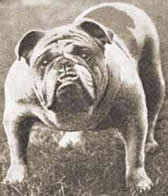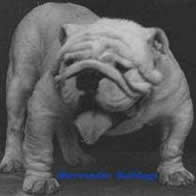
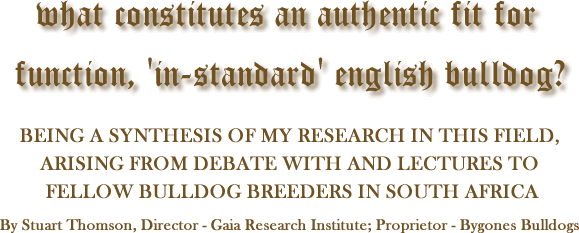 |
||||||
 |
||||||
| Period perfection, circa 1900. My candidate for a compromise perfect Bulldog |
||||||
| The topic of what constitutes an authentic fit-for-function
‘In-Standard’ English Bulldog’ was debated between
myself and fellow breeders over a period of months in an e-mail thread
that I started, titled “Bulldog Debate”. All known Bulldog
Breeders were included in the circulation list to afford everyone
an opportunity to participate. Hendrik van der Merwe of Mervander
Bulldogs and Frans Muller of Wolgemuth Bulldogs made class idiots
of themselves. Kassie Kasselman of Kassinja Bulldogs, chairman of
the Cape Bulldog Club, of which I am a member, was the only breeder
to put up any quality debate worth rebutting, leaving my thesis and
supporting arguments unscathed by the entire Bulldog Breeding fraternity
and remaining unchallenged to this day on all matters of fact.
My extensive research over several months of the original published literature from that period in which the Standards were authored and implemented, was put forward in support of my hypothesis that actual representatives of the intended idealised dogs must have existed around that time and hence can be used to properly inform our interpretation of the Standard. I present this here in the form of a more cohesive unified lecture. Any reader wishing to receive the full uncensored e-mail thread bearing all inputs and responses and which prints to in excess of 50-pages, now a open access public document, need just e-mail me at director@gaiaresearch.co.za
The first rudimentary Bulldog Standard in 1865 was intended to preserve the old English Bulldog that existed prior to the disastrous out-crossings to the Chinese Pug around the mid-1800’s and the second Standard in 1875, based on the first, was changed to accommodate the then established Pug-outcrosses and two decades later, after incorporation, to accommodate the trendy exaggerations that accelerated the decline of Bulldog health and welfare. The bottom line is: depictions of Bulldogs at these critical periods are the only means to determine historical intent. Centuries earlier, English Bulldogs were imported to Spain as war dogs and selectively bred there emphasising their mass. Between 1868 to 1873, return importation of the offspring of these Spanish English bulldogs increased the bulldog size previously reduced somewhat by the Chinese Pug out-crosses in England and also held promise to cancel out some of the damage to the Bulldog genome caused by the Pug outcrossings, by return-in-crossing more authentic Spanish English Bulldog genes to the Pug-bulldogs. These developments were the genesis of the defensive Bulldog Standard infighting that still continues to the present, as witnessed by the KUSA moratorium. The Spanish crosses incensed Pug-bulldog breeders
who considered their then 50lb dog as purportedly specifically bred
for bull-baiting, to be the most authentic British Bulldog. This
is not as clearcut as it might at first seem, since earler English
Bulldogs in the hands of farmers, butchers, dog-fighters and traditional
bulldog fanciers and also the Spanish return-imports, were of greater
purity than the Pug Bulldog outcrosses. It was concern over this
Spanish invasion that led to the formation of the Bulldog Club in
1875 to defend their Pug outcrossed Bulldogs. In January 2011 the writer wrote to the President of the Bulldog Club Inc (U.K.), Mr Chris Carberry, as follows: “I (Stuart Thomson) am somewhat perplexed that the oldest Bulldog club in the world, ‘established to promote the breeding of pure Bulldogs of the true type, and to urge the adoption of such type upon breeders, judges, committees, and promoters of canine exhibitions’ no longer seems to be committed at this time, if indeed ever since 1894, to that lofty aim. My observation stems primarily from comparing the image of Hutchison's 1908 Perfect Bulldog used in your Club banner, with the winners of your Club's Bulldog of the Year for the last 33 years, since 1977, as illustrated on your website. This is also evident from your Centenary photographs and even your Down Memory Lane collection, which shows the last true pure type appearing circa 1910 with CH Leone Hazelwyn.” The curt reply: “You are of course entitled to your opinion. There will be no further response from this club. (T. Carberry).” So there you have it, the late great Bulldog Club Inc, but let us return to my Bulldog authenticity thesis, which, I note, is fully in line with the Kennel Club’s recent pronouncements. At least, unlike the U.K. Bulldog Club, the U.K. Kennel Club is better late, than never, and after more than a century of the Bulldog Club having its way, has acted. The Kennel Club's preamble to the 2009 revised Bulldog Standard reads: "A Breed Standard is the guideline which 'describes' the ideal characteristics, temperament and appearance of 'a breed'. Absolute soundness is essential. Breeders and judges should at all times be careful to avoid obvious conditions or exaggerations which would be detrimental in any way to the health, welfare or soundness". Well, that certainly disqualifies most current conformation show Bulldogs and also pet Bulldogs for sale and adequately explains their breeder’s perverse resistance to a more explicit, health-focussed Standard, that clearly disqualifies Bulldogs suffering from a legacy of a century of uncontrolled exaggerations for competition’s sake. My Gaia Bulldog Report presents irrefutable evidence that practically everything that show bulldog breeders, judges and administrators have achieved this past century to the present has been detrimental in 'every' way to the health, welfare and soundness of this breed. No-one, myself included, can claim to possess or breed a ‘healthy Bulldog’, not yet, but I believe I understand the way to get to that objective, which is not possible without honest humility. The U.K. Kennel Club's (note, not the Bulldog
Club) post-amble to the Bulldog Breed Standard reads: The U.K. Kennel Club, in January 2009 announced
Healthy New Year Regulations for Pedigree Dogs, stating: “The
breed standards - the picture in words that describes each breed
of dog - have been revised so that they will not include anything
that could in any way be interpreted as encouraging features that
might prevent a dog from breathing, walking and seeing freely.
The changes represent a major additional step forward for the long
term health and welfare, made following a series of reviews, which
included breed experts and independent scientific and veterinary
experts”. Note that this clearly says 'each'
breed and not 'envisaged' breed. If the reader has any information to the contrary, please submit this to me for my consideration. My contextual comments appear in brackets interspersed throughout the presentation of supporting evidence in green text. Please note that I am working chronologically from the period of greatest importance to that of lesser importance. The passage of time serves mainly to reiterate first principles and also to definitively document the degeneration of the Bulldog under the perverse influences of exaggeration to outdo the opposition and later, blind copycat fashions. Let me state categorically that I am not suggesting that we restrict ourselves to breeding Bulldogs from the 1875 era. That would be impossible, since those authentic Bulldogs are essentially extinct, and I must make it clear here, this is entirely as a direct result of widespread mal-interpretation of and non-conformation to the Breed Standard then adopted by the Bulldog Club. That revered Club itself, nineteen years after adopting the well-intentioned Standard, was hijacked upon incorporation in 1894, by the very type of flashy snob Bulldog Breeder that is today so opposed to the U.K. Kennel Club’s ‘better late than never’ revisions to the Breed Standard as an urgent attempt to save the Bulldog from biological extinction at the hands of just such self-revealed callous, selfish, ignorant scum. What I am suggesting, is that ethical breeders urgently salvage, return to and re-invigorate the Bulldog genome under their care with whatever authentic Bulldog genes still remain in Bulldogs that were previously stupidly discarded for decades as reject pet Bulldogs by ignorant breeders selecting in their foolish pursuit of exaggeration. The mark of a true authentic Bulldog breeder should be the degree to which their Bulldogs bear characteristics of the authentic traditional old Bulldogs illustrated in this thesis, provided that the stock used is from registered pure-bred Bulldogs, rather than as a result from out-crossings to foundation breeds, which is not at all my intention. Bulldog conformation should accordingly be judged and awarded in competition to the degree that they so comply. |
||||||
 |
||||||
| I submit into Evidence the following: My earliest record, the 9th edition of the 'Encyclopædia Britannica’, (1875) pronounced on the bulldog thus: "The actual lay back Bulldog type is according to Bulldog historians, the result of Pug blood influx which over time became fixed into a less tall, but more clumsy animal with Pug-like face proportions." |
||||||
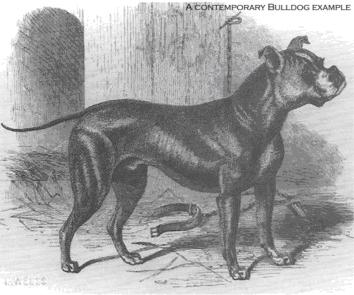 |
||||||
| L. Wells’ impression of a contemporary Bulldog, circa 1875 | ||||||
| (The above encyclopaedia entry was accompanied by a drawing by the artist L Wells, illustrating a then "contemporary bulldog" (i.e. 1875, precisely the era of the first conformations to the Breed Standard then adopted by the Bulldog Club), representative of bulldogs of that earliest Bulldog Club era that accurately documents the historical Bulldog morphology intended to be preserved by and pertaining to the English Bulldog Breed Standard that became official then. Note the long forelegs, long body, long tail and long snout, all hallmarks of authenticity.) | ||||||
 |
||||||
In that same year
that the Standard was adopted,
Charles
Darwin, in his book ‘The
Variation of Animals and Plants under Domestication’,
Vol. 1, Lond, 1875), also stated his own scientific
opinion even more bluntly thus:
“Some of the peculiarities characteristic of the several breeds
of dog have arisen suddenly, and, though strictly inherited, may
be called ‘monstrosities’,
for instance, the shape of the head and the under-hanging jaw in
the bulldog. A peculiarity suddenly arising, and deserving to be
called a
‘monstrosity’,
may be increased and fixed by man’s selection”.
(Clearly, the early warning signs were already in the layperson’s and professional scientist’s domain in the very year that the Bulldog Club was formed to preserve the old Bulldog that was already facing extinction, not least due to breeder out-crossings and selection for grotesque mutations. If observers and scientists were already alarmed at relatively minor mutations, then they are now fully justified to lament the dead-end future that the Bulldogs currently face. It is a sad indictment of the Bulldog breeder fraternity to note that even now, in the breed’s urgent 11th hour, ignorant and or selfish considerations still prevail to the point that breeders will put the breed at risk of extinction, either by reproductive impossibility and/or an by an eventual international ban on showing and even breeding, imposed on welfare grounds, which I would not oppose were it to come down to allowing the suffering to continue.) |
||||||
 |
||||||
John Henry Walsh (FRCS), a Committee Member of the Kennel Club and Editor of the influential sporting magazine, ”The Field”, in Part III, Chapter I ‘The Bulldog and Mastiff’ of his book ‘The Dogs of the British Isles’ (Horace & Cox, 1882) provides a detailed reliable early perspective (I provide a mere précis to make my point as to what was in the minds of the founding members of the Bulldog Club when they authored the Breed Standard) thus: “Until the early part of the nineteenth century the bulldog was bred with great care in this country for the purpose of baiting the bull, because he was exactly suited to the purpose; his nature being to run at the head of the animal he attacks, and after laying hold (‘pinning’) to maintain it in spite of any amount of punishment, short of insensibility from injury to his brain. The large head was indispensable and the skin covering it well wrinkled.” “To permit his keeping his wind while holding on to the bull, the nostrils, wide and open, must be set as far back as possible behind the level of his teeth, or the soft and yielding substance of the lip would suffocate the dog, and hence the breeders have always insisted on the necessity of a shortness of the face to such an extent as is never seen in any other variety of the species.” “The chest must be very wide and deep, giving a great girth, the thickness of brisket being specially to be noted as different from that of all other dogs in reference to the width between the elbows. The forelegs should be stout, short, straight, and well clothed at the arm. The elbows should be set on to the true arm wide apart, the arm itself turned out at the elbows and sloping out from the shoulder joint.” Note from the period drawing above and those below, how moderate these defining morphological characteristics were then, relative to the modern exaggerations. Modern conformation showdogs are fakes. They are not Bulldogs. “Soon after the enforced
cessation of bull-baiting, the breeding of bulldogs was in great
measure put a stop to. The bulldog
is only to be regarded as a remarkable curiosity in natural history;
but as such it would be a great
pity to lose him. Gradually, for want of encouragement, the ‘pure
breed’ became more and more rare, even with the aid of the
original Bulldog Club.” “Mr Vero Shaw has kindly placed his kennel at my disposal for illustration, and I have selected two specimens from it to show the peculiarities of the breed in a marked degree. The foreshortened sketch of the dog exhibits the formation of the chest, shoulders, width of skull, and ‘rose’ carriage of ears peculiar to the breed, while the bitch’s side view shows her wonderfully short face and ‘roached’ loin, rather met to the same extent. Their pedigrees are as follow: The dog, ‘Smasher’, by Master Gully, out of Nettle, by Sir Anthony. The bitch, ‘Sugar’ (formerly Lily), is by the Abbot out of Mr. J. L. Ashburne’s Lola, and was bred by the latter gentleman.” |
||||||
 |
||||||
| J.H. Walsh's sketch of the Bulldogs, Smasher and young Sugar, circa 1880 | ||||||
(Whilst it is true that all of the underlined descriptive sections above and below, fit the Standard, it is nevertheless a fact that modern showdogs have little to no correlates in history from the critical time of the founding of the Bulldog Club and the authoring and adoption of the Standard, in which milieu, logically, the Standard once applied and should still apply in its purest form in pursuit of true conformation to the Standard as per its declared original intention and raison d’être. The “peculiarities” described above pertain to the illustrations from the foundational period of the Bulldog shown above and below and in conjunction with the remaining earliest period photographs catalogued below, clearly illustrate the then limited degree of these peculiarities relative to the monstrous dysmorphism of the present show Bulldog and which exaggerations are directly responsible for the currently peaking concerns over the health and welfare of contemporary Bulldogs. Clearly therefore, to the extent that past, current and future Bulldogs match the Bulldogs of that era, to that extent alone are they pure-bred authentic Bulldogs and vice versa and clearly the more highly or lowly they should be judged. The Standard has not changed, only the dogs have and the latest revision on health and welfare grounds is merely a more explicit version of the original, facilitating a return of the Bulldog to the type from an era when Bulldogs did not suffer daily from mal-interpretation of its conformation and could procreate without the now almost universally considered essential invasive veterinary interventions.) |
||||||
 |
||||||
Rawdon
Lee, in his book 'A
History and Description of the Modern Dogs of Great Britain and
Ireland', (Horace Cox Ltd., 1894),
provides some interesting perspectives on developments in the late
1800's thus:
In Chapter IX, titled "The Bulldog", Lee wrote as follows: "Time is known to play grim jokes with historical monuments, but it probably has never burlesqued anything more than it has our national emblem, the British bulldog. To say that bulldogs are bred to-day (1893) on the same lines as they were even sixty years ago (1833 – just before their activities being legislated against) would be an assertion that could not by any evidence be defended". "The standard laid down for this breed has not materially altered during the last twenty years (1875, when the Standard was adopted), though judge's decisions may have sometimes been at variance with, if not diametrically opposed to the standard type". "The average weight of bulldogs is now (1893) from 40lb to 50lb, and of bull bitches 35lb to 45lb, but dogs have been shown as heavy as 65lb (30kg) within the last three years (since 1890)". (Permissible maximum weights were later increased by 5lb to allow the changing dogs to fit the standard) "One thing there always will be against the actual popularity of the bulldog, is the great difficulty there is in breeding first-rate specimens. Inbreeding, huge heads, and malformation of chest and forelegs are no doubt responsible for this state of things, nor is it likely matters will improve at any early date. Anything approaching deformity, weakness, or crippledness is rightly considered highly objectionable, though this point does not appear to be always clearly ascertained.” (The rot of exaggeration had already started to erode adherence to the well-intentioned Standard. Implicated in mal-reproduction was inbreeding [a.k.a. line-breeding], huge heads and malformation of chest & forelegs.) “Many good, sound, and active bulldogs flourished to about 1882." (There you have it, the unfettered reality. Lee’s book was written 12-years after this date, incidentally was the year that the British Bulldog Club was established, by which time there were apparently already no really good, sound and active dogs on the conformation show circuit for more than a decade. Only degenerates were in vogue. The history of purebred bulldogs is very much a history of the breeders and their organisations, who determined throughout, what direction the bulldog would take, and are now again neglecting the bulldog more than ever in its most critical hour of need.) |
||||||
 |
||||||
Hugh Dalziel, Honorary Secretary of the Bulldog Club in 1875, in Chapter VII, 'The Bulldog', in his book titled: 'British Dogs: Their Varieties, History, Characteristics, Breeding, Management and Exhibition' (The Bazaar Office, 1897) elaborates on what were considered ideal bulldogs of the past and then present (abbreviated) thus: “The outline of 'Rosa', in the well-known print of ‘Crib and Rosa’, is considered to represent perfection in the shape, make, and size of the ideal type of the bulldog. The only exception that has ever been taken is that it has been alleged to be deficient in wrinkles about the head and neck, and also in substance of bone in the limbs. This, however, does not alter the fact of its being a correct representation of the true type of the old-fashioned bulldog. Some allowance should be made for her sex - never as grand and well developed as dogs - and her position in the drawing.” |
||||||
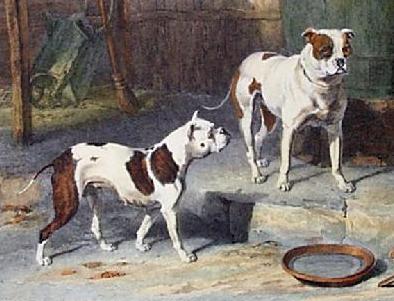 |
||||||
| Abraham Cooper's impression of the Bulldogs, Crib and Rosa, 1811 | ||||||
| There we have it
again, 113-years ago and from an icon of the dog world, the founding
Secretary of the Bulldog Club, the authors of the Breed Standard,
'after Incorporation' and the 1894 'pragmatic omission' of reference
to the then truly-extinct 'Rosa type' from the Standard, clearly stating
3-years after omission, near the turn of that epochal century for
the English Bulldog, that "the outline of 'Rosa'
is considered
to represent perfection in the shape, make, and size of the ideal
type of the bulldog, a correct representation of the true type of
the 'old-fashioned' bulldog". Clearly this was and remained
the type intended by the Standard authored and adopted by the Bulldog
Club in 1875 and still considered by the Club’s founders to
be the ideal near the turn of the century, even though Rosa had lived
in the 1st quarter of that 19th Century, before the disastrous outcrosses
with the Pug in the mid-19th Century. Mr Hugh Dalziel, mentioned an outstanding living Bulldog as representing that ideal (abbreviated), thus: “An engraving of another very good specimen, though not perfect, is of Mr. Donkin's 'Byron', a red dog by Gibbon's Dan ex Rose, by Tiger ex Bush; Tiger by Crib, broad in muzzle, with ‘good legs’ and chest.” |
||||||
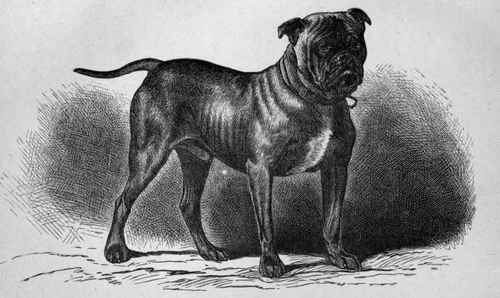 |
||||||
Byron,
circa 1878. An exemplary Bulldog 3-years after adoption of the Breed
Standard |
||||||
| (Around this time, the first photographs of bulldogs began appearing in print and for my purpose, provide a more reliably accurate record of the Bulldogs from this critical period so central to my Bulldog authenticity thesis. All period Bulldog photographs, not just the selection that follows, undisputedly serve to fully corroborate my thesis. Fortunately for the Bulldog as a viable breed, remnants of original gene quanta dating to this critical period also continue to be carried over, generally very poorly in living show bulldogs, but often very richly in pet Bulldogs in the care of commoners, from where I predict, this noble breed might yet be saved, in spite of the obstructive toffee-nosed show-dog fraternity, if the importance of this task can be urgently communicated and implemented, hence my vehement objections to the KUSA Moratorium on the Revised Breed Standard and my support for revisions). | ||||||
 |
||||||
| Edgar
Farman, Honorary Member of the Bulldog Club and Editor
of the Kennel Gazette, in his book 'The Bulldog - A Monograph',
(The Stock Keeper Co, Ltd., 1899), provides
considerable rare photographic evidence and also highly authorative
reliable detailed descriptive historical information to this present
controversy (abbreviated) thus:
In Chapter VI, titled 'Description of a Bulldog', Farman wrote as follows: "The Standard drawn
up by the Bulldog Club Inc is a carefully compiled description of
an ideal Bulldog. … It is one thing, however, to read
a formal description, and another to apply it, and can
only become experts by constant observation of the various specimens
exhibited at the shows 'now' held. …
It would tax the ability of the
smartest to grasp (example) without actual observation and comparison.
... The standard description of
the 'old English Bulldog' was drawn up by the Bulldog
Club in 1875, after the very 'early days of the breed’s
existence as a show dog'.
This record of what the national dog should be is perfectly
identified with 'old England',
and he is a dog of which Englishmen may be proud." (Don’t
be deluded into thinking this is your pitiful modern show bulldog.) (Clearly, the Bulldogs then on the bench were already degenerate. Modern show-bulldogs are their descendents. The hard to swallow truth for most breeders is that authentic Bulldogs live on only in some pet Bulldog lineages.) "Inbreeding has been going on to an alarming extent with the result that ... to make it better fit the dog, a statement in the standard that ‘the outline of Crib and Rosa is considered to nearly approach perfection in shape, make and size of the ideal type of the Bulldog’, after nearly a quarter of a century, the committee of the Bulldog Club (Incorporated) in 1894 ruthlessly dragged Rosa from her high estate because the present day animals will not fit her beautiful outline. Her retention became a farce in consequence of the continued disregard to her model by the judges one and all. The description of the English Bulldog of the Bulldog Club was drawn up by the Bulldog Club in 1875, after ascertaining the views of 'old breeders' upon the subject." (In short, show bulldogs, even a century and more ago, were but a degenerate shadow of their former glory.)
Shall we here present tonight do anything to support the 'Old'
English Bulldog? The gentlemen present exclaimed in one voice ‘Yes’ and the Club formed. The work of the was the framing of its rules, the preparation of a standard description and arrangements for promoting the welfare of the Bulldog." (Look at the Bulldog Club Inc today.
Under the likes of its subsequent presidents, the Club became as
degenerate as the member’s bulldogs, utterly unfit for any
purpose other than to stand witness to the absence of any morality.) In Chapter XI, titled 'The Objects of the Club', Farman, very importantly to this controversy, wrote as follows: "The Standard Description was proposed in the catalogue of the first show held by the Club at the Alexandra Palace on June 14 and 15, 1876, and as a matter of history, it is interesting to note the animals then named as considered to approach and fairly represent the true type, though not each faultless." (This statement informs the original purpose of show-dog conformation competitions, which was not to change the Bulldog breed, but rather merely strive to perfect individual specimens by eliminating the variable faults that will variably exist in each.) "A Standard Description of the Bulldog was drawn up and adopted after full weight was given to the previously drawn up description of what an 'Old English Bulldog' ought to be by Philo-Kuön in 1865, and this Standard Description is now (1899) the same as then. The (only) exception, two omissions (made nineteen years later by the Committee in 1894, when the Club was incorporated), namely the Statement that the outline of Rosa was considered to nearly approach perfection in the shape, make, and size of the ideal Bulldog; and that no living (or dead, for the matter of that) specimens are now referred to as fairly representing the true type described, and sought to be preserved and perfected." (The pure Old English Bulldog for which both Bulldog Clubs and Standards were formed and adopted, with the purpose of preserving, had at the hands of breeders and judges, arrived at the brink of extinction and was quietly, nearly completely killed off by the then Committee of the Bulldog Club Incorporated, to hide the unsavoury fact that they had utterly failed the founders of both clubs and their noble objectives.) (Personally, I am not sentimental
over the loss of the Philo-Kuön era Bulldog that was already
long a relic of the past and all but technically extinct as a separate
strain by the time the Bulldog Club Standard was authored to model
the then current evolution of the Old English Bulldog, which undeniably
existed prior to its mutation into the previously non-existent wide-shouldered,
short-legged monstrosities that started to appear around 1894 following
incorporation. Clearly, the Standard was changed via strategic model
omissions, to match the degenerating breed.) |
||||||
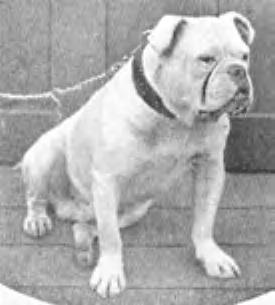 |
||||||
| Champion Datholite, circa 1886, an exemplary
Bulldog specimen, a decade into the Standard |
||||||
| (Edgar Farman’s earliest photos of period Bulldogs included the exceptionally good specimen, Champion Datholite. In spite of many such dogs with long forelegs, which helped to retain a good measure of proportion, there is in his photographic selection, increasing evidence of manipulation towards the unnatural, broad-chested monsterism that became increasingly apparent henceforth with the passage of time as shorter and shorter achondroplastic legs were selected for and which led increasingly to more severely crippled dogs. See my Gaia Bulldog Report.) | ||||||
 |
||||||
| H.W. Huntington, in an article titled 'Exaggerated Types of Bulldogs', (Outing, Vol. 36, Issue 2, May 1900), provides further detail to this present controversy (abbreviated) thus:
"Perhaps within the last decade (i.e. 1890-1900) no breed has been so tampered with as the bulldog, or so subjected to the innumerable whims of the faddist. By some he has been transformed into little else than a monstrosity. One characteristic after another has been made paramount, till many prize winners seem, to the true lover of the breed, little else than cripples." "The
perfect-to-type bulldog should be active, full of life and vigour.
How many can we find to-day that are? Of a verity, not upon our
present-day show benches! Each judge has his own
conception of the perfect dog, irrespective of what the standard
calls for. No marked and emphatic
improvement can or will be seen in this breed till the club sends
forth its edict that the dog shall be judged by the standard
adopted. If not, of what use is a standard?" |
||||||
 |
||||||
| W.
D. Drury, in the chapter ‘The Bulldog’
in his book, ‘British Dogs’ (Charles
Scribner, 1903), wrote as follows: “As to whether the fancier has improved the breed constitutionally is a moot point. No dog is more deceptive than the Bulldog. His strong, muscular, heavy-boned frame and sturdy appearance suggest a dog of almost unlimited powers of endurance, and it is hard to realise that he is one of the most delicate of all the canine creation. His poor constitution is entirely due to the inbreeding that has been practised for generations. The purpose of this has been to secure and perpetuate certain desirable points, otherwise impossible to establish permanently. And the points have been secured, but at the cost of a delicate and degenerate constitution.” |
||||||
 |
||||||
James Watson, in Ch. 25, ‘Bulldogs’, in Vol. II of his book titled: ‘The Dog Book’ (Doubleday, Page & Co, 1906) recalled having repeatedly as a child visited the best bulldog kennels outside London with the father of a schoolboy companion and having seen many coloured patched white and brindle with white bulldogs, leading him to state half a century later, as follows: “Not only is it our own recollection, but the illustrations of dogs of that period are all to the effect that the bulldog of 1855-60 was totally unlike the dog of to-day (1905). He was ‘only moderately low on the leg’, and stood closer in front than our ‘exaggerations’ do. His tail more frequently than not was a plain whip tail, and he ‘lacked the massiveness of head’ of the later dog”. “This period was up to 1868. We were again in England from 1877 to 1880. Meeting Alfred George at the Alexandra Palace Show, when looking at the bulldogs, we said something about the alteration in them, and we can recall almost word for word his reply: ‘Oh, there has been a great change since you went away. You will see some of the old sort at father's, but they don't do for showing’." “The first presentable bulldog shown in America was in 1880, the lightweight 'Donald', about the best lightweight in England at that time. We do not think the dog was so leggy as the photograph shows him to be, but he could not have been a low dog, though we do not remember him as any way out of the ordinary … with exaggeration such as we see in some bulldogs when the excess of some property approaches the line which marks the monstrosity. A very sound man in the ring goes for good type, while at the same time he does not care for anything like an excessive exaggeration.” |
||||||
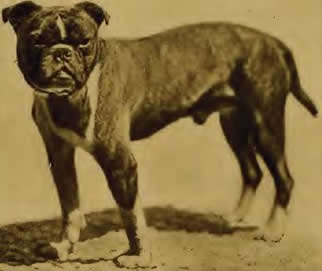 |
||||||
| Donald, circa 1880. An exemplary Bulldog 5-years into the Standard | ||||||
| “It is useless for fanciers to argue that the present-day dog is the same as the old sort. The old ones were good dogs, undoubtedly. Strong, active bulldogs, possessed of character, and from conformation and strength fully fitted to show that their name was not misapplied. Not one of them, however, would get beyond the VHC (Very Highly Commended) stage and then more than likely it would take an all-round judge devoid of specialty fads to recognise its merits. 'Monarch' was such a step in advance in many ways that he moved the ideal mark quite a distance ahead and made the breed more than ever a 'fancy variety'.” | ||||||
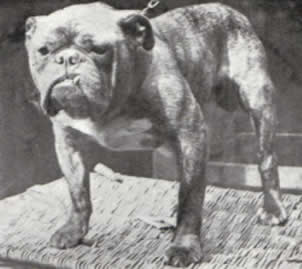 |
||||||
Champion British Monarch, circa 1884.
|
||||||
| “The difficulties in breeding
bulldogs are many. There is first the getting a bitch that will breed,
for many are incapable. Then the demands of fancy often render the
birth of puppies very hazardous. Finally, if the puppies are born
alive and the dam survives, will she suckle her puppies? We find that
a large number of the best bulldogs are from unknown dams, more of
the kind that a dog man will style ‘a rare good one to breed
from’. While not up to show form, these are capable of giving
birth to their puppies without any more than the normal amount of
risk, and will rear them without assistance.” (I have included the above for its valuable insights applicable to my theme of the degeneration of the modern show dog vs. the authenticity of traditional bulldogs not so damaged by the assault of relentless severe exaggerations. Please note that the breeding problem of which he writes, were already, at the turn of the century, evident in the showdogs, even then necessitating the use of more traditional females to birth the show Bulldog monstrosities. However, in order to “fix” the monstrous physical characteristics, female offspring needed to be line-bred, which eventually necessitated Caesarean section births to reduce the high mortality and loss of monetarily valuable puppies, which challenge will yet have to be faced up to by breeders in the foreseeable future as the number of C-section births are to be restricted in future in the interests of producing healthier dogs) [James Watson was born in Scotland in 1845, grew up in England where visited many prominent British breeders and attended early British dog shows, emigrated to America in 1870 and provided a vital link between American and British fanciers, returning to England frequently to purchase top dogs for breeders. Watson's profession as a journalist provided him with opportunity to both promote purebred dogs and to report on the dog world as kennel editor for multiple newspapers and editor of several publications. In 1883 Watson launched the American Kennel Register, also the first U.S. magazine devoted exclusively to dogs. A founding member of the American Kennel Club, following a long period as an independent, he was made chairman of both the Stud Dog and Rules Committees of the A.K.C. in 1892. In 1898, Watson was appointed the first editor of the American Kennel Gazette. In 1900 he left to again found his own dog magazine, Field and Fancy. Watson is best known among dog historians and book collectors as the author of The Dog Book cited above, considered to be the finest early work on dogs in America, where today the purebred bulldog is considered to be more authentic than those of its native country.] |
||||||
 |
||||||
Robert Leighton, in his book titled 'Dogs and All About Them' (Cassell & Co. Ltd., 1910), on describing Bulldog morphology, confirmed its application to an early reference specimen thus: '"The Bulldog is known to have been domiciled in this
country for several centuries. The body
was broad, muscular, and
compact, as is shown in Scott's
well-known engraving of 'Crib and Rosa'. The specimens alive in
1817, as seen in prints of that period, were not so cloddy as those
met with at the present day. Still, the outline of 'Rosa'
in the engraving
of Crib and Rosa, is considered to represent perfection in the shape,
make, and size of the ideal type of Bulldog. The commencement
of the dog-show era in 1859 provided a fresh incentive to the dog
fancier to breed Bulldogs. It is to their efforts that we are indebted
for the varied specimens of the breed that are to b e seen at the
present time." (The Bulldog Club Breed Standard logically had only these actual period degrees of grandeur in mind in its description of the ideal Bulldog and certainly did not intend that these features be so artificially exaggerated beyond the degree that optimised the renowned functional utility of the Bulldog that the Standard intended to preserve, yet subsequent breeders actively engaged in such monsterism that rendered the high utility Bulldog utterly useless for its traditional, indeed any other utility purpose and cruelly rendered it a perpetually suffering veterinary disaster.) |
||||||
 |
||||||
| F
Barrett Fowler, Honorary Secretary of the London Bulldog
Society, in the Introduction to his revised edition of the 1914 book
by Henry St John Cooper titled 'Bulldogs' (Jarrolds,
1925), wrote as follows: “Some 15-20 years ago (1905-1910), a vast number of cripples, unhealthy and grossly exaggerated specimens of the breed were being exhibited, and what is worse, winning prizes. It is certainly not an easy task to compare the dogs of 1890, 1900 and 1910 with those of the present day (1925). During those years (1890-1910) we had without question some of the finest specimens ever on the show bench, or ever likely to be bred. The present-day Bulldog is not, and cannot be, so good as the dog of the past. Unfortunately the dogs of today are not to be compared with those of the past. No doubt in time, we shall fall back on the old production, and perhaps even beat the noted dogs of that time." "At one time it was the aim of some breeders to produce the most exaggerated specimens possible. They misread the Standard and taught others to misread it also (much as Hendrik vd Merwe and others are still doing today). The Standard declared that the skull of the Bulldog should be large. Every effort was now made to make it abnormally so. The Standard required great width of chest, with short (relative to the hindlegs), sturdy, muscular, but straight forelegs. These breeders set to work to produce a dog that was nothing more nor less than a gross caricature of what he should be. It was not uncommon to see an unfortunate animal waddling helplessly round the ring after his master." "While these exaggerations of form were being produced, it was at the cost of the dog’s stamina and health. What was the result? With greater and greater frequency, distorted, crippled, and short-lived dogs were exhibited at the shows and were only too frequently awarded prizes. ... Imagine such a creature as this tackling a bull or putting up a two hours fight in the dog pit. We no longer wanted the fierce dog of the earlier days, but we did not want the helpless, rickety, pampered creature that was utterly unworthy of the name of 'Bulldog'. I (Barrett Fowler, Honorary Secretary of the London Bulldog Society) know for a fact that in producing these exaggerations, cruelty even worse, because longer drawn out, than was ever practiced in the bull-ring or pit was used." "To prevent the dog from 'going up on the leg', and to give it an appearance of great width of chest which it did not possess, various instruments of torture were used. Some of the 'more' humane, or I might say, the less barbarous, loaded their dogs during their puppyhood with a kind of harness generally made of leather, with sometimes the addition of metal. This harness was so contrived that two large stuffed leather pads were secured between the forelegs of the dog, spreading them out and causing the unfortunate animal to waddle miserably about the kennel yard instead of enjoying its puppyhood as every puppy has a right to." "Others, I have been told, though I cannot vouch for the truth of it, placed heavy weights and secured them on the shoulders of the young and growing animal. But the worst form of all was that adopted by a few barbarians. This was to confine the growing puppy in a hutch-like place of which the roof or top was so low that it was never possible for the wretched animal to stand upright. ... It meant the utter degeneration of the Bulldog." |
||||||
 |
||||||
| (Whilst this practice
is likely unthinkable today, the perverse legacy remains, not only
in the minds of those modern breeders who still find a sense of delight
in such relics of the Bulldog's darkest past, but moreover in those
demonstrating this perversion by selecting and concentrating remnants
of this trait in their own show-dogs, in particular, where line-bred
lineages still reproduce, or stock from these lineages still throw
such torturous genes and produce varying degrees of such monstrosities
by virtue of there being no alternative genes in the extremely depleted
and limited gene pool to allow nature to return more normal morphology
via gene-selection homeostasis.) (The only means out of such closed studbook practices is logically to allow normal genes from pure-bred pet and hobby bulldogs to cross with such deliberately narrowly line-bred dogs, which may still sometimes satisfactorily allow normalisation to occur via deliberate invigorating gene-pool diversification. Sadly, this seldom happens intentionally as witnessed below, including two South African examples illustrated on the right of the group below.) |
||||||
|
||||||
 |
||||||
| Ernest
Baynes & Louis Fuertes, in their book titled
‘The Book Of Dogs – An Intimate Study Of Mankind’s
Best Friend’ (National Geographic Society,
1919) expressed compassion for Bulldogs and
disdain of breeders thus:
“The bulldog
of today is a grotesque
deformity
– short-legged, short-winded, short-lived, and barely able
to reproduce its kind. It is chiefly useful
for infusing courageous blood into other breeds, for adding variety
to a dog show, and as an example
(to be avoided) of what can be done by senseless breeding to spoil
a perfectly good dog. But they haven’t quite spoiled
him, for he still retains his old-time dauntless courage, and he
has a homely smile that would melt the hearts of even the few unfortunates
who boast that they hate dogs.” |
||||||
 |
||||||
| A.
G. Sturgeon in his book, titled 'Bulldogdom'
(Abel Heywood & Sons Ltd., Manchester, 1920)
remarked: "Comparisons between the present day dog (1920), and reliable prints and pictures of the old-timers will reveal the most marked changes in their general appearance. Detail in nearly every particular has altered. At the time this is being written (90 years ago and 25 years after incorporation and removal of reference specimens from the Standard), there appears to be less first-class Bulldogs in the country than for many years. Of course, dogs have been winning challenge certificates, but generally, the dogs winning first today are not as impressive and faults are prevalent. The high-water mark, in the writer’s opinion, was reached in the year 1909 (a decade before time of writing, now more than a century ago)". |
||||||
 |
||||||
| Conclusion
This last entry concludes my review of the early evidence and I believe, undisputedly corroborates my ‘authenticity’ thesis. To wrap-up, let me summarise the thesis and the evidence submitted, from a less formal perspective.
In the case of Bulldog conformation to the Standard, the oldest breed standard in the world, actual such Bulldogs existed at the time of the adoption and immediately subsequent application of the Standard on the then new phenomenon of the show-dog circuit. Logically, the top 'breed foundation dogs' from that period represented the breed so idealised and described and should inform our interpretation of the Standard, which had as its intention, to circumscribe the application of the Standard to the preservation of the old Bulldog. The only latitude the Standard afforded to club members was in fact an obligation to minimise or eliminate faults in their kennel lineages. This was not a competition rewarding the creation of a new breed, let alone a breed with the most faults and novel serious health problems. The first Bulldog Club and Standard were superseded by a second a decade later in order to broaden the membership base to accommodate half a century of change to the earliest foundation, but by then extinct working Bulldogs. Clubs, their committees and members come and go with the passage of time, but the Standard, until superseded, remains cast in stone. The Standard has recently been substantially revised by the highest authority over the Bulldog, the U.K. Kennel Club, administrative owner of England’s National Dog, now for the first time so extensively, since 1875. The Standard has however, not changed in the slightest. It has merely been carefully revised to circumscribe the description of the Bulldog to that intended by the 135-year old version and only to the degree that breeders over that period have mal-interpreted the original. See my notated comparative versions here That subsequent breeders, judges and administrators somehow erroneously read conformation into the hoards of mutants is beyond my comprehension other than to conclude, sadly, indeed angrily, that exaggerations at all costs to create a more-fancy animal in an attempt to outdo the competition were put before any considerations of the welfare of the dogs themselves. I shall not even go into the shocking collaborative veterinary medical literature at this time, other than to remind you that according to Dr Lucy Asher (BSc, PhD) of the Royal Veterinary College, Herts, in the U.K.: "The Bulldog suffers 42 inherited disorders, 16 of which are conformation related and 2, conformation exacerbated. Current breed standards give breeders financial incentive to continue inbreeding and until breed standards are amended, it may be difficult to convince breeders otherwise." (Asher L et al, ‘Inherited defects in Pedigree Dogs. Part 1: disorders related to breed standards’, Vet J, 182(3), 2009) Whilst I am not suggesting an impossible return to the extinct phenotypes, I am claiming, brutally so, that most, if not all current showdogs are in fact not bulldogs at all compared to many pure-breed pet Bulldogs alive today and that accordingly, it is appropriate that we all honestly determine which bulldogs today are more fake than fact of all living so-called bulldogs and stop awarding them false accolades and start honouring the more authentic Bulldogs alive today by recognising them for their priceless genetic worth and accordingly award them the accolades so long overdue to them. Bulldogs that exhibit serious inherited disorders, and that is virtually all show bulldogs, should not be allowed to procreate (and can’t do so anyway without veterinary intervention, so perhaps veterinarians should be held accountable by their professional and regulatory associations and be disciplined, charged and prosecuted). Ignorant human interference over time has dealt cruel blows upon the Bulldog. The photos of Champions Donald, Datholite, Monarch and most others of the critical period between 1875 and 1894 bear witness to the phenotype of the true old Bulldog and when compared to the manipulated monsters and degenerate specimens appearing circa 1890, clearly demonstrates the 'fact' that the mutant freaks put up since then and especially today, became less and less Bulldog as phenotypic genes were progressively discarded throughout the passage of the Victorian era. With rare exception, mainly amongst pet bulldogs, living specimens
of the breed scarcely deserved the name “Bulldog” from
the Edwardian era onwards and although WWI did afford the Bulldog
some respite, the post-war show-dog era dealt knockout blows to
what few unfortunate truer Bulldogs were still left on the bench.
The fundamental Bulldog genotype, as witnessed by these grossly
mutated physical phenotypes and a disproportionate propensity for
serious health problems, had clearly become so depleted of the essence
of the traditional old Bulldog, as to have little resemblance to
the old Bulldogs that the Standard of 1875 was intended to preserve.
|
||||||
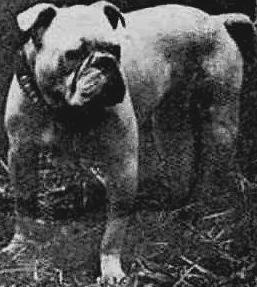 |
||||||
Champion Surplice, Circa 1880 |
||||||
| The illustration I have used throughout (below) to separate evidential entries is of unknown origin and period and with the possible exception of its large ears and short tail, I consider it to be a good example of the old English Bulldog that the original Standard sought to preserve and improve by eliminating any faults (such as the oversized ears). A dog of this type would not be out-of-Standard with the original 135-year old Standard, nor the recent revised Standard, which latter would serve to eliminate most competing current conformation show-bulldogs. | ||||||
 |
||||||
| What a sound modern bulldog ought to look like. | ||||||
| Parting
shot I consider it shameful that amongst the entire bulldog fraternity in this country, I, a mere novice, have assumed, by default, the roles of bulldog health and welfare researcher and activist and now, additionally, bulldog conformation historian. (A heated, uncensored e-mail debate with the selfish South African Bulldog breeder fraternity, printing to over 60 pages and upon which this short lecture above is based, is available from the author, upon request at: director@gaiaresearch.co.za Yours sincerely, for Bulldogs the world over,
|
||||||
 |
||||||
| Bygones Bunty conversing with the author | ||||||
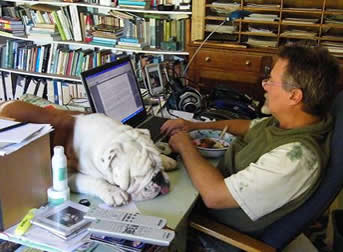 |
||||||
| Humphrey of Bygones, default Bulldog representative, with the author | ||||||
| Personal Postscript
The best male Bulldog I have at the moment is my Humphrey of Bygones, who makes contemporary show Bulldogs look absolutely ridiculous with their short bodies and their short, stumpy forelegs. |
||||||
 |
||||||
| Humphrey of Bygones. An exemplary specimen. | ||||||
| The best female Bulldog I have at the moment is young Lady Becci of Bygones, whose rich traditional gene repository may get me to closer to the traditional old type Bulldog faster than I had previously hoped for with Bunty. | ||||||
 |
||||||
| Newest long-fore-legged Lady Becci of Bygones | ||||||
Thank you ever-so-much
for your valuable time and interest in real Bulldogs and their serious
modern dilemma. |
||||||
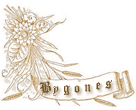 |
Bygones Bulldogs is copyright © 2009. Bygones Bulldogs all rights reserved |
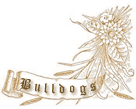 |
